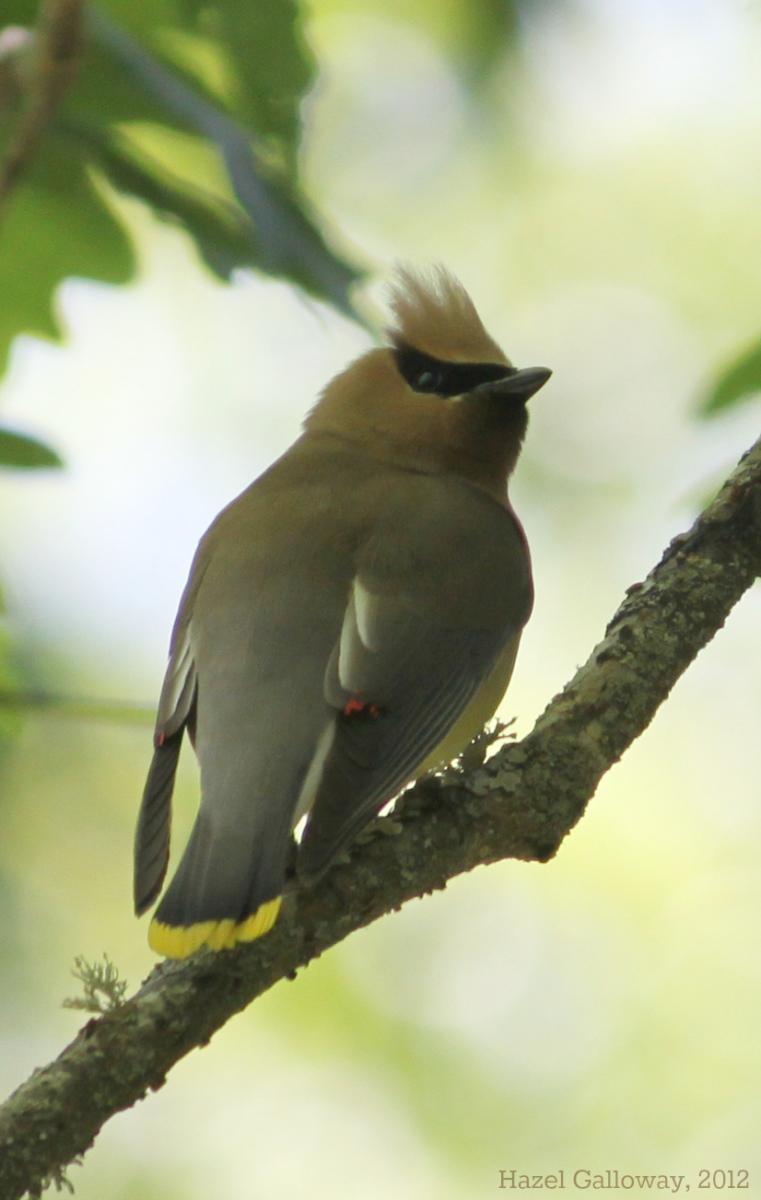 The cedar waxwing is a sleek, plump bird with silky plumage. Although the grey-brown coloration on their back and breast is unremarkable, they simply look different than many other common species of birds in this area. In fact, they are one of only three species in the monogeneric family Bombycillidae, the others being the bohemian waxwing (B. garrulus) and the Japanese waxwing (B. japonica). Several other species—mainly exotics currently classified in monotypic families—have been recommended for inclusion in subfamilies within Bombycillidae, although the taxonomy is still unclear. Perhaps the waxwings’ closest North American relatives are the silky-flycatchers, a group of four species of long-tailed, similar-sized birds inhabiting the southwestern US and Central America. However, no other species in the Bombycillidae family, extended or otherwise, are to be found in this region.
The cedar waxwing is a sleek, plump bird with silky plumage. Although the grey-brown coloration on their back and breast is unremarkable, they simply look different than many other common species of birds in this area. In fact, they are one of only three species in the monogeneric family Bombycillidae, the others being the bohemian waxwing (B. garrulus) and the Japanese waxwing (B. japonica). Several other species—mainly exotics currently classified in monotypic families—have been recommended for inclusion in subfamilies within Bombycillidae, although the taxonomy is still unclear. Perhaps the waxwings’ closest North American relatives are the silky-flycatchers, a group of four species of long-tailed, similar-sized birds inhabiting the southwestern US and Central America. However, no other species in the Bombycillidae family, extended or otherwise, are to be found in this region.
Cedar waxwings are larger songbirds, often measuring 15 cm. (6 in.) in length. They are grey-brown overall with pale yellow coloration on their breast and belly; however, they sport bright accents of color on their wings and tail. Their secondary wing feathers are tipped with small, brilliant red droplet-like marks, and their square tails end with a bright yellow band. They also have a distinctive black mask edged with white around their eyes.
These birds are very gregarious, and live socially in groups even during the breeding season. During periods of migration and in the winter, they can be found in flocks numbering in the hundreds or thousands. They are nomadic birds, travelling from place to place with the exception of during the breeding season in June-August. Their breeding range is limited to the northern half of the US and the southern half of Canada; however, their winter range extends as far south as Panama. Vagrant birds are also occasionally spotted in central Alaska, Iceland or Great Britain.
Cedar waxwings are monogamous during the breeding season, forming pairs that often raise two broods of young over the course of the summer. During courtship, males perform a hopping dance and offer the female pieces of fruit, insects, or flowers.  Responsive females will imitate the hopping and pass the item back to the male, a sequence that may be repeated many times. After mating, females usually lay 4-5 eggs in as many days and then incubate the nest for 11-13 days until the chicks hatch. During this time, the male will bring her food and guard the nest, often perching in high, exposed places to give advance warning of any approaching predators. When a nest is threatened, both parents may try to distract the predator by flying in a zig-zag pattern away from the nest, or threaten the intruder by diving at it.
Responsive females will imitate the hopping and pass the item back to the male, a sequence that may be repeated many times. After mating, females usually lay 4-5 eggs in as many days and then incubate the nest for 11-13 days until the chicks hatch. During this time, the male will bring her food and guard the nest, often perching in high, exposed places to give advance warning of any approaching predators. When a nest is threatened, both parents may try to distract the predator by flying in a zig-zag pattern away from the nest, or threaten the intruder by diving at it.
Both the male and the female maintain the nest by removing the fecal sacs made by the chicks, which they either eat or drop outside of the nest. The pair continues to feed and care for the young for more than a week after they fledge. From the laying of the eggs until the point when the young form social groups with other fledglings and become independent, the each pair of cedar waxwings invests well over a month into each brood of young.
During the winter, cedar waxwings rely heavily on berries as a food source; indeed, there is speculation that recent growth in their population is partly due to the spread of exotic fruiting plants. During the summer, they switch over to insects as their primary food source.
This individual was found recently dead on the Murray porch on Tuesday, likely as a result of an encounter with a window. Flocks of the cedar waxwings are often seen around the station in midsummer.
Hazel Galloway
Sources:
- Spellman, Garth M, et al. "Clarifying the systematics of an enigmatic avian lineage: What is a bombycillid?" Molecular Phylogenetics and Evolution 49.3 (2008): 1036-1040.
- http://animals.nationalgeographic.com/animals/birding/cedar-waxwing/
- http://animaldiversity.ummz.umich.edu/accounts/Bombycilla_cedrorum/



